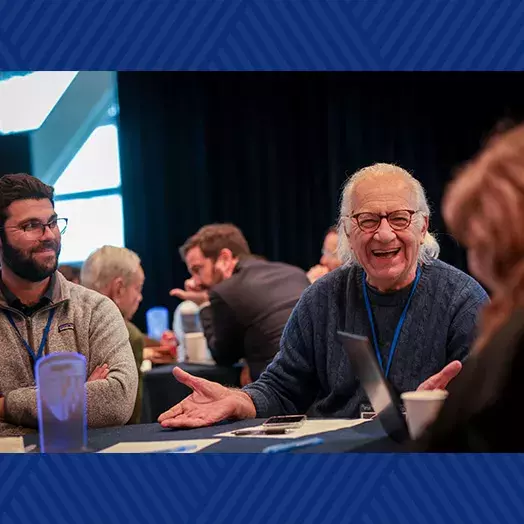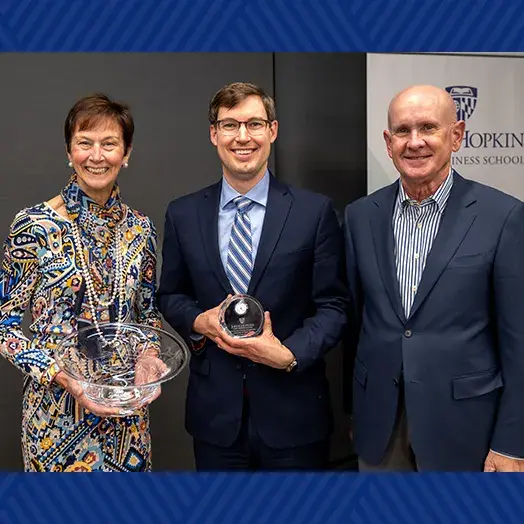A cross-section of business and policy scholars convened to discuss topics such as resilience, misinformation, and negotiation at an event designed to plant a seed for future research-focused collaboration.

"Thriving through Crisis and Conflict" conference aims to strengthen science and society through interdisciplinary collaboration
Crises and conflicts are everywhere, wreaking havoc on the best-laid plans of businesses and communities. They include catastrophic storms and shocking acts of military aggression, but also slower-moving threats like trade wars, pandemics, and climate change.
A conference at the Johns Hopkins University Bloomberg Center in Washington, D.C. brought together business-focused thinkers from the Johns Hopkins Carey Business School and policy-focused thinkers from the School of Advanced International Studies (SAIS) to talk about how they study these issues and what they can learn from each other.
The event, “Thriving through Crisis and Conflict? Interdisciplinary Insights for an Uncertain Future,” was funded with a Nexus Award, a grant program that encourages cross-disciplinary scholarship.
Brian Gunia, professor of management at Carey, and his fellow conference planners believe the event “planted the seed” for future research-focused collaboration that will break down existing silos.
“Ultimately the goal is to build a contemporary and interdisciplinary science of crisis and conflict anchored at Johns Hopkins.”
Brian Gunia, professor of management
“At the Carey Business School, we broadly take a behavioral approach to studying crisis and conflict in organizations — examining managerial, strategic, and economic implications. While many at SAIS study international conflicts and crises from a historical or case study perspective, examining implications for the international order,” says Gunia. Though both approaches are complementary, “disciplinary differences have traditionally prevented much integration.”
Yet business practices and global relations are deeply entwined. To give one example, presenter Naser Nikandish, associate professor of practice at Carey, noted that a staggering 43 countries contribute to manufacture of Apple phones.
“If one or two of those countries faces a problem or embargo, we will have issues,” he said.
What to Read Next

DEIB
Carey-sponsored Global Women’s Summit: Celebrating the impact and proving the value of investing in womenInterdisciplinary collaboration
About 60 people attended the event, about half affiliated with Carey or SAIS; the rest came from other Hopkins schools and other universities.
Even participants who weren’t part of the three interdisciplinary panel discussions (International Crisis and Conflict in the 21st Century, Domestic Crisis and Conflict in the 21st Century, and Crisis and Conflict Management Strategies for the 21st Century) were expected to contribute, not simply sit and listen.
Group discussions sessions brought together scholars from different disciplines with common interests related to crisis and conflict. The goal was to seed an interdisciplinary community of scholars focused on studying crisis and conflict from new perspectives. Each group reported to the wider gathering, leading to discussions on topics such as what makes a system legitimate, what is the role of misinformation, using AI to predict global risk, and examining peace-building through a negotiations research lens. Participants interested in collaborating on particular topics were connected after the conference.
“Ultimately,” says Gunia, “the goal is to build a contemporary and interdisciplinary science of crisis and conflict anchored at Johns Hopkins.”
Keynotes: World order and negotiation
The day was bookended by keynote speakers Kori Schake, senior fellow and director of foreign and defense policy studies at the American Enterprise Institute, who spoke about the place of the U.S. in an unstable world; and Gordon Donaldson Professor of Business Administration at Harvard Business School, James K. Sebenius, who spoke about negotiations as coordinated campaigns.
Schake, the opening speaker, brought a suitably somber note to a conference focused on crisis and conflict, noting that the international world order is now at risk and that last year, for the first time, interest payments on national debt in the United States exceeded the defense budget.
Sebenius, whose influential book, co-authored with David Lax, is “3-D Negotiation: Powerful Tools to Change the Game in Your Most Important Deals,” discussed deal-making and how much of the work takes place away from the negotiating table and includes creating coalitions, activating influencers, and creating conditions that make it more likely for a deal to fall into place.
A deal’s setup, he said, is the third dimension of negotiation, after negotiation tactics and the design of a potential settlement. It’s the place for creative moves like attracting allies, persuading potential defectors, and influencing alternatives.
I. William Zartman, Jacob Blaustein Distinguished Professor Emeritus of International Organization and Conflict Resolution at SAIS, voiced his agreement in a panel on crisis and conflict management strategies, noting that negotiations typically don’t begin until there is a “mutually hurting stalemate,” a concept that applies to everything from salary negotiations to working toward Middle East peace. His idea, known as ripeness theory, suggests that it may be necessary to bring one side to the point of pain in order to incentivize negotiations. At a workplace, that could mean a worker threatening to quit; in international negotiations, it could be the cost of war growing too large to ignore.
Yet, he said, it’s important to think about how to prevent conflicts, instead of allowing unstable conditions to fester.
“We need to pay more attention to starting negotiations in the first place,” agreed Gunia. “When do people actually choose to start negotiations?”
Gray areas and resilience
Yet, as several speakers noted, negotiations, like crises, do not have obvious beginnings and ends.
“In the last 15 years or so, I have been part of a shift in how we’re thinking about questions of domestic violent conflict,” said SAIS Associate Professor Dipali Mukhopadhyay. Lines between war and peace, militants and civilians, and even civil versus international war are blurry at best, he said.
Carey presenters Kathleen Sutcliffe, Bloomberg distinguished professor and professor emerita, and Associate Professor Michelle Barton, spoke of their work understanding how businesses and the people in them respond to adverse events.
“A lot of people think of resilience as recovery, but it’s something that organizations, individuals, and teams can do before, during, and after adversity,” said Sutcliffe. She noted that even small events, like a new competitor or a supply chain challenge, can trip up companies. The ones that succeed have team members who work well together and are comfortable adjusting their responsibilities to meet changing conditions.
“We’re coming to see resilience as something that people do rather than something they have,” said Barton. “It’s a set of practices to help organizations absorb strain. So many crises that we deal with are long-term. Resilience is something that has to be ongoing.”
Looking forward, the conference planners are organizing collaborations on the many important and intriguing ideas that emerged.
“We are excited to continue building an interdisciplinary community focusing on studying crisis and conflict,” said Gunia.


